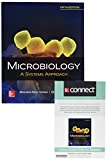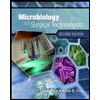
GEN COMBO LOOSELEAF MICROBIOLOGY:A SYSTEMS APPROACH; CONNECT ACCESS CARD
5th Edition
ISBN: 9781260149364
Author: Marjorie Kelly Cowan Professor
Publisher: McGraw-Hill Education
expand_more
expand_more
format_list_bulleted
Question
Chapter 3, Problem 1CM
Summary Introduction
To create:
The concept map that illustrate the relationships among given key terms.
Concept introduction:
Culturing of microbes is a method of multiplication of microorganisms in a defined culture medium. It is performed under controlled temperature and other conditions to identify the various types of the microbes. A media is required to provide proper nutrients to the microbes that are being cultured.
Expert Solution & Answer
Want to see the full answer?
Check out a sample textbook solution
Students have asked these similar questions
What is the structure and function of Eukaryotic cells, including their organelles? How are Eukaryotic cells different than Prokaryotic cells, in terms of evolution which form of the cell might have came first? How do Eukaryotic cells become malignant (cancerous)?
What are the roles of DNA and proteins inside of the cell? What are the building blocks or molecular components of the DNA and proteins? How are proteins produced within the cell? What connection is there between DNA, proteins, and the cell cycle? What is the relationship between DNA, proteins, and Cancer?
Why cells go through various types of cell division and how eukaryotic cells control cell growth through the cell cycle control system?
Chapter 3 Solutions
GEN COMBO LOOSELEAF MICROBIOLOGY:A SYSTEMS APPROACH; CONNECT ACCESS CARD
Ch. 3.1 - Explain what the Five Is mean and what each step...Ch. 3.1 - Discuss three physical states of media and when...Ch. 3.1 - Compare and contrast selective and differential...Ch. 3.1 - Provide brief definitions for defined and complex...Ch. 3.2 - Prob. 5AYPCh. 3.2 - Prob. 6AYPCh. 3.2 - Prob. 7AYPCh. 3.2 - Prob. 8AYPCh. 3.2 - Compare and contrast the three main categories of...Ch. 3 - Prob. 1MCQ
Ch. 3 - A mixed culture is a. the same as a contaminated...Ch. 3 - Resolution is ____ with a longer wavelength of...Ch. 3 - A real image is produced by the a. ocular. b....Ch. 3 - Prob. 5MCQCh. 3 - The specimen for an electron microscope is always...Ch. 3 - Prob. 7MCQCh. 3 - Bacteria tend to stain more readily with cationic...Ch. 3 - Multiple Matching. For each type of medium, select...Ch. 3 - A fastidious organism must be grown on what type...Ch. 3 - Agar has the disadvantage of being easily...Ch. 3 - A subculture is a culture made from an isolated...Ch. 3 - Prob. 13TFCh. 3 - Prob. 14TFCh. 3 - The best stain to use to visualize a microorganism...Ch. 3 - What is the functional type of mannitol salt agar...Ch. 3 - Create a short paragraph to differentiate among...Ch. 3 - Prob. 3CTQCh. 3 - a.Create a paragraph to differentiate among the...Ch. 3 - You are a scientist studying a marsh area...Ch. 3 - Visual Connections Blooms Level 5: Evaluate These...Ch. 3 - Prob. 1CM
Knowledge Booster
Similar questions
- In one paragraph show how atoms and they're structure are related to the structure of dna and proteins. Talk about what atoms are. what they're made of, why chemical bonding is important to DNA?arrow_forwardWhat are the structure and properties of atoms and chemical bonds (especially how they relate to DNA and proteins).arrow_forwardThe Sentinel Cell: Nature’s Answer to Cancer?arrow_forward
- Molecular Biology Question You are working to characterize a novel protein in mice. Analysis shows that high levels of the primary transcript that codes for this protein are found in tissue from the brain, muscle, liver, and pancreas. However, an antibody that recognizes the C-terminal portion of the protein indicates that the protein is present in brain, muscle, and liver, but not in the pancreas. What is the most likely explanation for this result?arrow_forwardMolecular Biology Explain/discuss how “slow stop” and “quick/fast stop” mutants wereused to identify different protein involved in DNA replication in E. coli.arrow_forwardMolecular Biology Question A gene that codes for a protein was removed from a eukaryotic cell and inserted into a prokaryotic cell. Although the gene was successfully transcribed and translated, it produced a different protein than it produced in the eukaryotic cell. What is the most likely explanation?arrow_forward
- Molecular Biology LIST three characteristics of origins of replicationarrow_forwardMolecular Biology Question Please help. Thank you For E coli DNA polymerase III, give the structure and function of the b-clamp sub-complex. Describe how the structure of this sub-complex is important for it’s function.arrow_forwardMolecular Biology LIST three characteristics of DNA Polymerasesarrow_forward
arrow_back_ios
SEE MORE QUESTIONS
arrow_forward_ios
Recommended textbooks for you
 Microbiology for Surgical Technologists (MindTap ...BiologyISBN:9781111306663Author:Margaret Rodriguez, Paul PricePublisher:Cengage Learning
Microbiology for Surgical Technologists (MindTap ...BiologyISBN:9781111306663Author:Margaret Rodriguez, Paul PricePublisher:Cengage Learning- Basic Clinical Lab Competencies for Respiratory C...NursingISBN:9781285244662Author:WhitePublisher:Cengage



Microbiology for Surgical Technologists (MindTap ...
Biology
ISBN:9781111306663
Author:Margaret Rodriguez, Paul Price
Publisher:Cengage Learning



Basic Clinical Lab Competencies for Respiratory C...
Nursing
ISBN:9781285244662
Author:White
Publisher:Cengage